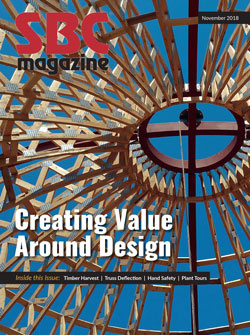Truss Deflection Changes You Should Know About
Truss Deflection Changes You Should Know About
Truss designers who design trusses for use in jurisdictions where the 2015 or 2018 International Building Code® (IBC) has been adopted may have noticed a change in the way deflection is reported on the truss design drawings. This change is due to a new deflection criterion added to ANSI/TPI 1-2014 to correspond to the limits established in the IBC for deflection due to dead load plus live load (D + L). Because of this change, most trusses designed using TPI 1-2014 will have a lower D + L deflection than trusses designed using TPI 1-2007.
Beginning with the 2015 IBC, a revision was made to a footnote for Table 1604.3 (see digital edition for tables and figures) to clarify the original intent of the building code with respect to the D + L deflection limits. This revision made it clear that the deflection limit for the D + L combination applies strictly to the creep component of long-term dead load deflection plus the short-term live load deflection. In other words, it only pertains to the deflection that occurs after the immediate deflection caused by the application of the dead load.
In order to establish a deflection criterion for metal-plate-connected wood trusses that directly corresponds to the clarification to the footnote in Table 1604.3, TPI 1-2014 now includes the deflection limit, ∆CR, where,
∆CR = the deflection due to live load plus the creep component of deflection due to dead load,
= ∆LL + (KCR-1) x ∆DL.
And
∆LL = deflection due to the live load component of the design load
∆DL = immediate deflection due to the dead load component of the design load
KCR > 2.0 for seasoned lumber used in dry service conditions
> 3.0 for green lumber or for seasoned lumber used in wet service conditions
A comparison of the deflections calculated using TPI 1-2007 and 2014 for an 18-inch-deep floor truss is provided in Table 1 and shown in the truss design drawings in Figures 1 and 2.
A comparison of the values in Table 1 indicates that ∆T using TPI 1-2007 criteria for trusses with seasoned lumber is greater than ∆CR using TPI 1-2014 for trusses with seasoned lumber. Further, ∆T using TPI 1-2007 criteria for trusses with green lumber (or for wet service conditions) is the same as ∆CR using TPI 1-2014 for trusses with green lumber.
Table 7.6-1 of TPI 1-2014, includes deflection limits for live load only (∆LL), deflection due to live load plus creep component of deflection due to dead load (∆CR), and deflection due to total load (∆TL).
The limits for live load deflection (∆LL) correspond to the limits established in Table 1604.3 (see sidebar) of the 2015 and 2018 IBC for live Load (L), snow load (S), and wind load (W). The limits for creep deflection (∆CR) correspond to the limits established for dead load (D) plus live load (L), i.e., D + L. The limits for ∆TL in Table 7.6-1 are provided for situations when the building designer requires that a check due to total load be performed.
TPI 1-2014 does not require the dead load component of ∆TL to be adjusted for creep. However, the building designer may specify an adjustment that may require modification of the truss deflection criteria used in the software. It is very important for truss designers evaluating the building designer’s plans and specs to pay careful attention to all applied load conditions and deflection limits and ask for clarity if needed. Ultimately, a component manufacturer’s (CM) best practice is to ensure that the building designer and the CM both agree that all the design loads and serviceability considerations are properly accounted for and signed off on. This will lead to a final design that meets everyone’s expectations.
∆T = KCR∆LT + ∆ST
Where:
∆LT = immediate deflection due to long term component of the design load (deflection due to a sustained load, typically dead load)
∆ST = deflection due to short term or normal component of the design load (deflection due to transient loads, typically live load)
KCR = time dependent deformation (creep) factor
> 1.5 for seasoned lumber used in dry service conditions (i.e. moisture content (MC) of member remains less than 19% for lumber)
> 2.0 for green lumber or for seasoned lumber used in wet service conditions (i.e., MC > 19%).
∆T, is compared with the corresponding D + L deflection limits provided in Table 1604.3 of the IBC.

